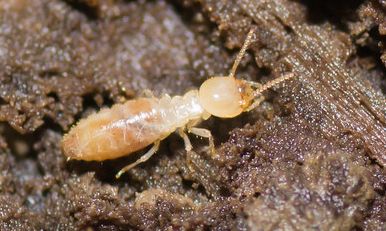Subterranean Termites
What to Know About Subterranean Termites in Central Florida
Subterranean termites, or Rhinotermitidae as their Latin name is, are the most common species of termites in the US and in Central Florida, in particular.

Identification Factors
#1. Size & Overall Appearance
These termites are usually ⅛ inch long, have six legs, and a long, narrow, oval shape. Most subterranean termite soldiers and workers are typically smaller than the soldiers and workers in drywood termite colonies.
#2. Color & Distinctive Features
You will recognize these species of termites by their creamy white to dark brown/black coloring. They are considered the most destructive species of termites because of their saw-toothed jaws.
#3. Behavior, Diet, Habits
As their name suggests, subterranean termites prefer to live in the soil, just beneath and around homes. They enter through wood with direct contact to the ground or by building tunnels, typically referred to as “mud tubes,” to reach cracks in foundations made of hollow blocks and concrete walls. These insects use their scissor-like jaws to eat through wood, books, and other cellulose- and plant-based products
When do subterranean termites swarm in Florida?
Subterranean termites go off to start new colonies in the spring. There is typically one primary queen per colony that can lay tens of thousands of eggs in its lifetime. However, supplementary reproductives in established colonies can also lay eggs.
Signs of Infestation
- Damaged Wood – these termites leave a distinctive honeycomb pattern in softer spring wood, forming tunnels inside and leaving the external grain intact.
- Swarmers – in the presence of warmer temperatures and heavy rainfall, established colonies are triggered to send out a swarm of winged termites. If you see swarmers, you see trouble.
- Piles of Wings – once the swarmers have mated, they shed their wings. If you see piles of what looks like fish scales on your windowsills, and they are all the same size, you are most probably in need of a termite treatment.
The Solution
No two termite problems are alike, so it is you are having an infestation problem, is best to have your termite services provider devise a custom treatment plan for your specific situation. Meanwhile, avoid water accumulation near the foundations of your home to prevent infestations.
If you fear you might have termites in your home, reach out to Total Pest Services for professional and timely assistance!
